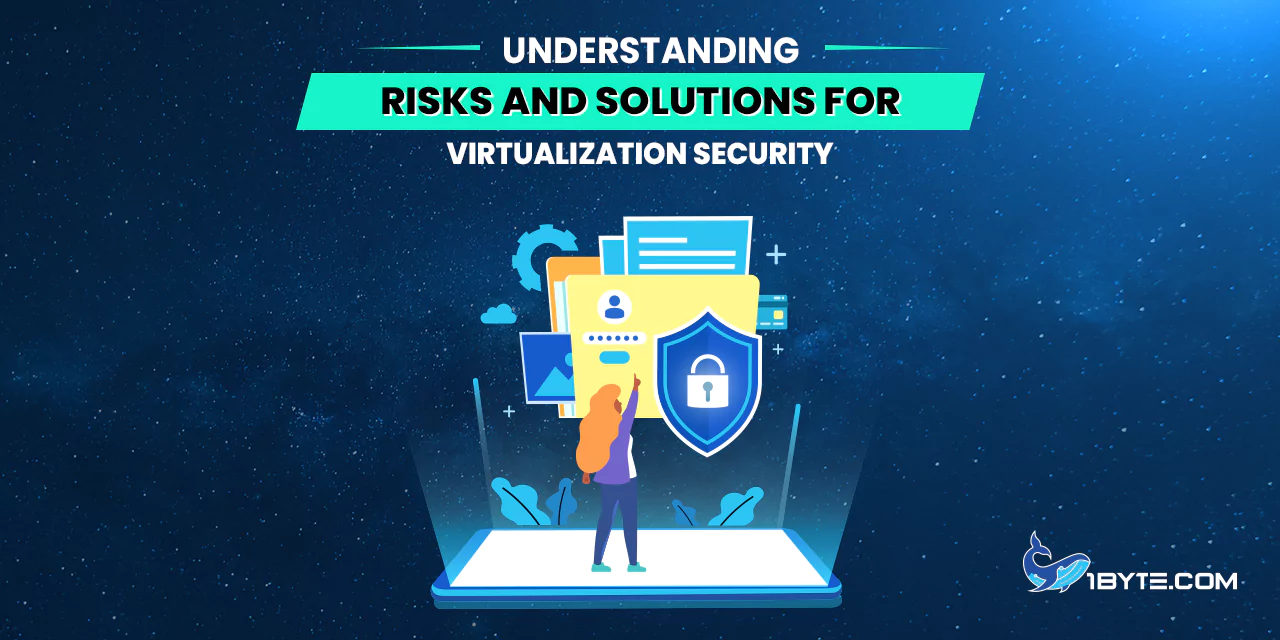In today’s digitally driven landscape, businesses rely heavily on virtualization to optimize resources and streamline operations. However, with increased virtualization comes the imperative need for robust virtualization security. This article delves into the risks that virtualization exposes organizations to and presents effective solutions to mitigate these threats.
As technology advances, so do the methods employed by cybercriminals. Ensuring the security of virtualized environments is no longer a choice but a critical necessity. By comprehending the potential risks and learning about proactive solutions, businesses can fortify their digital infrastructure and confidently embrace the benefits of virtualization while keeping cyber threats at bay.
An Overview
In the realm of modern technology, where virtualization reigns supreme, safeguarding sensitive data and systems is paramount. This section provides a comprehensive virtualization security overview, shedding light on the risks that emerge in virtualized environments and unveiling strategies to counteract them.
Definition of virtualization security
Virtualization security refers to the strategies and measures implemented to protect the integrity, confidentiality, and availability of data and systems within virtualized environments. It addresses the unique challenges posed by virtualization technologies, ensuring that the benefits of resource optimization and scalability do not compromise the overall security posture.
In virtualized settings, multiple virtual machines (VMs) share a single physical server, creating potential points of vulnerability. Virtualization security involves safeguarding against unauthorized access, data breaches, malware propagation, and other cyber threats. It encompasses both proactive measures, such as access controls and encryption, as well as reactive responses to detect and mitigate potential attacks.
By integrating comprehensive virtualization security measures, organizations can confidently harness the advantages of virtualization while maintaining a robust defense against evolving cyber risks. This includes implementing advanced techniques to isolate VMs, secure hypervisors, and secure communication channels, all of which collectively contribute to a more secure digital landscape.
Importance in the modern digital landscape
In the fast-evolving digital world, the significance of virtualization security cannot be overstated. As businesses increasingly adopt virtualization to optimize resources and streamline operations, the potential risks and threats become more pronounced.
Virtualization has revolutionized IT infrastructures, enabling the efficient utilization of hardware resources and the rapid deployment of services. However, this very efficiency can inadvertently create openings for cyberattacks. Hackers are quick to exploit vulnerabilities in shared resources and unprotected communication channels.

With sensitive data and critical applications residing within virtualized environments, the consequences of a security breach can be catastrophic. Breaches can lead to data leaks, financial losses, legal liabilities, and reputational damage. Moreover, as organizations move towards cloud-based architectures and hybrid environments, the importance of robust virtualization security amplifies, as these setups introduce additional complexities and points of vulnerability.
By proactively addressing virtualization security concerns, businesses can foster a secure and resilient digital ecosystem. Implementing stringent access controls, regularly updating security patches, and fostering a culture of cybersecurity awareness are pivotal in safeguarding virtualized systems.
Recommended reading: How Desktop Virtualization Revolutionizes Work
3 Risks in Virtualization Security
While virtualization offers numerous benefits, it also introduces unique security challenges. In this section, we delve into three key virtualization security risks that organizations must be aware of to safeguard their digital assets effectively.
Vulnerabilities in shared resources
The shared resource model in virtualization, while efficient, creates potential vulnerabilities. Multiple virtual machines (VMs) coexisting on a single physical server can lead to VMs inadvertently affecting each other’s security.
Virtualization security hinges on the principle that isolation between VMs should be maintained, but vulnerabilities can arise if this separation is compromised. If a malicious actor gains access to one VM, they might exploit shared resources to infiltrate others. Similarly, a misconfigured VM might unknowingly expose sensitive data to neighboring VMs.
To counter these vulnerabilities, stringent access controls and segmentation measures are crucial. By implementing robust access policies and isolating VMs based on their respective security levels, organizations can minimize the potential for breaches stemming from shared resources. It’s imperative to establish clear boundaries between VMs, ensuring that the benefits of virtualization do not come at the expense of security.
Hypervisor-based threats
The hypervisor, a critical component managing multiple virtual machines (VMs), can become a focal point for virtualization security concerns. If compromised, the entire virtualized environment is at risk.
Malicious actors targeting the hypervisor can potentially gain unauthorized access to all VMs running on the same host. This makes the hypervisor a lucrative target, as compromising it provides a gateway to a multitude of VMs and the sensitive data they contain.

To address these threats, organizations must prioritize hypervisor security. This involves regularly applying security patches, limiting direct access to the hypervisor, and ensuring that it is kept up to date with the latest security practices. By fortifying the hypervisor, businesses can mitigate the risks associated with its potential compromise and bolster their overall virtualization security posture.
Data breaches across virtual machines
One of the key virtualization security risks lies in the potential for data breaches across different virtual machines (VMs). While VMs are intended to be isolated, vulnerabilities can lead to unauthorized access between them.
If a single VM is compromised, it’s possible for an attacker to pivot and gain access to other VMs on the same host. This can result in unauthorized data access, leakage, or even manipulation across VMs.
To counteract this risk, robust segmentation and access controls are vital. Properly configuring firewalls and access policies between VMs can restrict unauthorized lateral movement. Regular security audits can also help detect and prevent unauthorized interactions, safeguarding data and maintaining the integrity of the virtualization security framework.
Recommended reading: 5 Essential Tools for Simplifying Cloud Infrastructure Management
3 Key Solutions
Mitigating virtualization security risks requires proactive measures that align with the dynamic nature of virtualized environments.
Isolation techniques for VMs
Ensuring virtualization security requires deploying robust isolation techniques for virtual machines (VMs). These strategies create a secure environment even in the presence of potential threats.
Microsegmentation stands out as a powerful method. It involves dividing the network into smaller segments, allowing administrators to define stringent access controls for each segment. Even if one VM is compromised, attackers find it challenging to move laterally to other VMs.
Implementing access control lists (ACLs) within VMs can further bolster security. ACLs dictate which resources and services each VM can access, minimizing the exposure of critical components.
By leveraging these isolation techniques, organizations can establish a strong defense against threats, maintaining the confidentiality and integrity of data within virtualized environments. It’s a pivotal step towards achieving comprehensive virtualization security.
Regular security patching and updates
Maintaining strong virtualization security involves a proactive approach to patching and updating all components within a virtualized environment.
Security vulnerabilities can emerge over time, and attackers are quick to exploit them. By regularly applying security patches and updates to hypervisors, virtual machines, and associated software, organizations can close known security gaps.

Frequent updates ensure that the latest security features and fixes are in place, safeguarding against potential breaches. An up-to-date environment is less likely to be susceptible to attacks that exploit previously identified weaknesses.
Prioritizing regular security patching and updates is a fundamental practice that bolsters the overall virtualization security posture. By staying ahead of emerging threats, organizations can significantly reduce the risk of successful cyberattacks and ensure the integrity of their digital infrastructure.
Network segmentation and monitoring
For robust virtualization security, effective network segmentation and continuous monitoring play a pivotal role in maintaining a secure digital environment.
Network Segmentation involves dividing the network into separate zones, each with its unique security controls. By segmenting networks based on trust levels, organizations can prevent unauthorized lateral movement between virtual machines (VMs).
Continuous Monitoring is equally crucial. It entails real-time observation of network traffic and activities within the virtualized environment. Any unusual behavior or unauthorized access attempts are swiftly detected, allowing administrators to take immediate action.
Implementing network segmentation and monitoring provides a multi-layered security approach. It minimizes the potential for data breaches and unauthorized activities, ensuring that even in dynamic virtualized environments, the virtualization security remains uncompromised.
FURTHER READING: |
1.Virtual Machine Host 101: Everything You Need to Know |
2.How to Choose a Web Hosting Provider That Meets Your Needs |
3. Shared Hosting Prices: A Guide to Finding Affordable Options |
Leverage 1Byte’s strong cloud computing expertise to boost your business in a big way
1Byte provides complete domain registration services that include dedicated support staff, educated customer care, reasonable costs, as well as a domain price search tool.
Elevate your online security with 1Byte's SSL Service. Unparalleled protection, seamless integration, and peace of mind for your digital journey.
No matter the cloud server package you pick, you can rely on 1Byte for dependability, privacy, security, and a stress-free experience that is essential for successful businesses.
Choosing us as your shared hosting provider allows you to get excellent value for your money while enjoying the same level of quality and functionality as more expensive options.
Through highly flexible programs, 1Byte's cutting-edge cloud hosting gives great solutions to small and medium-sized businesses faster, more securely, and at reduced costs.
Stay ahead of the competition with 1Byte's innovative WordPress hosting services. Our feature-rich plans and unmatched reliability ensure your website stands out and delivers an unforgettable user experience.
As an official AWS Partner, one of our primary responsibilities is to assist businesses in modernizing their operations and make the most of their journeys to the cloud with AWS.
Conclusion
By understanding the risks associated with virtualization and adopting proactive solutions, businesses can secure their data, applications, and systems from potential breaches. The shared resource vulnerabilities, hypervisor-based threats, and data breaches across virtual machines all underscore the importance of a robust security strategy.
Remember, embracing isolation techniques for VMs, regular security patching and updates, and effective network segmentation and monitoring are key steps in fortifying your digital infrastructure.
As organizations continue to harness the power of virtualization, prioritizing virtualization security becomes a cornerstone of success. By doing so, you can confidently reap the benefits of resource optimization and scalability while ensuring the safety of your digital assets in an increasingly interconnected world.

